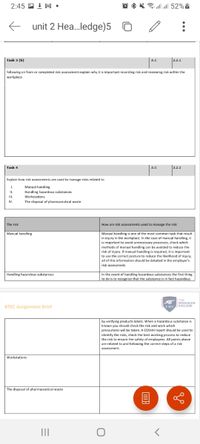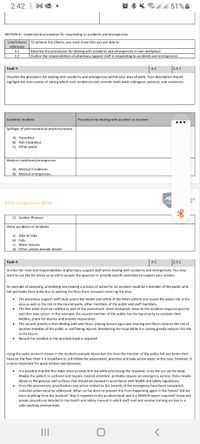
Phlebotomy Essentials
6th Edition
ISBN: 9781451194524
Author: Ruth McCall, Cathee M. Tankersley MT(ASCP)
Publisher: JONES+BARTLETT PUBLISHERS, INC.
expand_more
expand_more
format_list_bulleted
Question

Transcribed Image Text:2:45 回上M。
@ * * 7
all 52%|
E unit 2 Hea..ledge)5
Task 3 (b)
A.C
2.2.1
following on from or completed risk assessment explain why it is important recording risk and reviewing risk within the
workplace.
Task 4
A.C
2.2.2
Explain how risk assessments are used to manage risks related to
1.
Manual handling
Handling hazardous substances
Workstations
I.
I.
IV.
The disposal of pharmaceutical waste
The risk
How are risk assessments used to manage the risk
Manual handling
Manual handling is one of the most common task that result
in injury in the workplace. In the case of manual handling, it
is important to avoid unnecessary processes, check which
methods of manual handling can be avoided to reduce the
risk of injury. if manual handling is required, it is important
to use the correct posture to reduce the likelihood of injury,
all of this information should be detailed in the employer's
risk assessment.
In the event of handling hazardous substances the first thing
to do is to recognize that the substance is in fact hazardous
Handling hazardous substances
THE
WOOLWICH
COLLEGE
BTEC Assignment Brief
TWC
C
by verifying products labels. When a hazardous substance is
known you should check the risk and work which
precautions will be taken. A COSHH report should be used to
identify the risks, check the best working process to reduce
the risk to ensure the safety of employees. All points above
are related to and following the correct steps of a risk
assessment.
Workstations
The disposal of pharmaceutical waste
目
II

Transcribed Image Text:2:42 I Mk •
O * * llul 51%À
SECTION 3- Understand procedures for responding to accidents and emergencies
Unit/Criteria To achieve the criteria, you must show that you are able to
reference
3.1
3.2
Describe the procedures for dealing with accidents and emergencies in own workplace
Outline the responsibilities of pharmacy support staff in responding to accidents and emergencies
|A.C
2.3.1
Task 5
Describe the procedure for dealing with accidents and emergencies within your area of work. Your description should
highlight the main points of during which such incidences and consider both work colleagues, patients, and customers.
Accident/ Incident
Procedure for dealing with accident or incident
...
Spillages of pharmaceutical products/waste,
A) Hazardous
B) Non hazardous
C) Other waste
Medical conditions/emergencies
A) Medical Conditions
B) Medical emergencies
ICH
BTEC Assignment Brief
TW
C) Sudden illnesses
Other accidents or incidents
a) Slips or trips
b) Falls
c) Minor injuries
d) Other, please provide details
Task 6
A.C
2.3.2
Outline the roles and responsibilities of pharmacy support staff when dealing with accidents and emergencies. You may
want to use the list above as an aid to answer the question or provide specific examples to support your answer.
An example of assessing, prioritizing and making a process of action for an accident could be a member of the public who
fell and broke their ankle due to wetting the floor from rainwater entering the area.
The pharmacy support staff must assess the health and safety of the fallen patient and assess the water risk in the
area as well as the risk to the injured party, other members of the public and staff members.
• The first aider must be notified as part of the assessment. Once evaluated, move to the accident response priority
and then take action. In this example, the injured member of the public has the top priority to evaluate their
welfare, check for injuries and provide reassurance.
• The second priority is that dealing with wet floors, placing hazard signs and cleaning wet floors reduces the risk of
another member of the public or staff being injured. Monitoring the issue while it is raining greatly reduces the risk
in the future.
• Record the accident in the accident book is required.
Using the same scenario shown in the incident example above but this time the member of the public fell and broke their
head on the floor then it is important to still follow the assessment, prioritize and take action steps. In this case, however, it
is more important for quick actions and decisions.
• t is possible that the first Aider must provide first aid while prioritizing the response, since the cut can be deep.
Maybe the patient is confused and require medical attention, probably require an emergency service, there maybe
blood on the ground, and surfaces that should be cleaned in accordance with health and safety regulations.
• Once the assessment, prioritization and action related to the severity of the emergency have been completed,
remedial action must be addressed. What can be done to prevent this from happening again in the future? Did we
learn anything from the incident? Was it reported in the accident book and is a RIDDOR report required? Good and
proper procedures detailed in the health and safety manual in which staff read and receive training are key to a
safer working environment.
II
Expert Solution
This question has been solved!
Explore an expertly crafted, step-by-step solution for a thorough understanding of key concepts.
This is a popular solution
Trending nowThis is a popular solution!
Step by stepSolved in 3 steps

Knowledge Booster
Similar questions
- I need help Listing key takeaways, providing evidence for each of a long term care facility in a adminstrator office And how can I Choose 1 long-term and 3 short-term opportunities to eliminate inefficiencies, reduce waste, improve a product, or streamline a process within the organization.arrow_forwardNCLEX practice: Category: Safety and Infection Control A nurse is assessing a clinic patient with a diagnosis of hepatitis A. Which of the following is the most likely route of transmission? A. Sexual contact with an infected partner B. Contaminated food C. Blood transfusion D. Illegal drug usearrow_forward70arrow_forward
- 9 of 1 tion Biological Safety Cabinets are: Select one: O a. Primarily horizontal airflow hoods O b. Used only for non-hazardous sterile preparation O C. Classified into 3 categories depending on their ability to protect personnel from hazardous products O d. Located in the anteroom to protect all staff ce.ca/mod/quiz/attempt.php?attempt=186101&cmid=102359&page=39# Q Search LALO 069 Time left 22:27 重” oarrow_forwardWhat are two ways a healthcare provider could violate the HIPAA law, and what are alternative actions the healthcare provider could use to protect client confidentiality?arrow_forward44. A nurse is caring for a client who ----------- native American is being treated for metabolic alkalosis. Before discharge, which of the following will address the multidimensional needs of the client? (Select all that apply)a. Ensure the client is on strict bedrest.b. Consult the dietician.c. Conduct a cultural assessment.d. Provide emotional support.e. Provide education asap thanksarrow_forward
- Discuss some methodological approaches that can be utilized with pressure injury quality improvement projects and their strengths and benefits.arrow_forward1. How the MDGs differ from SDGs in term of goals, targets, focus/ scope, indicators and formulation. 2. How the Community Health Nursing lead in the success of MDGs and SDGs implementation.arrow_forward7 Which of the following principles do Health care professionals who are involved with compounding products need to comply with? Select one: O a. O b. O C. O d. Must have legal counsel in place before entering into manufacturing practices Must have a minimum of one Pharmacist on site per shift Must demonstrate a patient-health care professional relationship Must have a manufacturing assembly line process Ba Q Search Time left 23:35:16 1 WAL di do acerarrow_forward
- CC 12arrow_forwardNCLEX practice: A female patient is receiving furosemide (Lasix), 40 mg P.O. b.i.D. in the plan of care, the nurse should emphasize teaching the patient about the importance of consuming: A. Fresh, green vegetables B. Bananas and oranges C. Lean red meat D. Creamed cornarrow_forwardwhat are the main challenges and concerns surrounding the allied health professional strategy and its a ability to achieve environmental sustainabityarrow_forward
arrow_back_ios
SEE MORE QUESTIONS
arrow_forward_ios
Recommended textbooks for you
 Phlebotomy EssentialsNursingISBN:9781451194524Author:Ruth McCall, Cathee M. Tankersley MT(ASCP)Publisher:JONES+BARTLETT PUBLISHERS, INC.
Phlebotomy EssentialsNursingISBN:9781451194524Author:Ruth McCall, Cathee M. Tankersley MT(ASCP)Publisher:JONES+BARTLETT PUBLISHERS, INC. Gould's Pathophysiology for the Health Profession...NursingISBN:9780323414425Author:Robert J Hubert BSPublisher:Saunders
Gould's Pathophysiology for the Health Profession...NursingISBN:9780323414425Author:Robert J Hubert BSPublisher:Saunders Fundamentals Of NursingNursingISBN:9781496362179Author:Taylor, Carol (carol R.), LYNN, Pamela (pamela Barbara), Bartlett, Jennifer L.Publisher:Wolters Kluwer,
Fundamentals Of NursingNursingISBN:9781496362179Author:Taylor, Carol (carol R.), LYNN, Pamela (pamela Barbara), Bartlett, Jennifer L.Publisher:Wolters Kluwer, Fundamentals of Nursing, 9eNursingISBN:9780323327404Author:Patricia A. Potter RN MSN PhD FAAN, Anne Griffin Perry RN EdD FAAN, Patricia Stockert RN BSN MS PhD, Amy Hall RN BSN MS PhD CNEPublisher:Elsevier Science
Fundamentals of Nursing, 9eNursingISBN:9780323327404Author:Patricia A. Potter RN MSN PhD FAAN, Anne Griffin Perry RN EdD FAAN, Patricia Stockert RN BSN MS PhD, Amy Hall RN BSN MS PhD CNEPublisher:Elsevier Science Study Guide for Gould's Pathophysiology for the H...NursingISBN:9780323414142Author:Hubert BS, Robert J; VanMeter PhD, Karin C.Publisher:Saunders
Study Guide for Gould's Pathophysiology for the H...NursingISBN:9780323414142Author:Hubert BS, Robert J; VanMeter PhD, Karin C.Publisher:Saunders Issues and Ethics in the Helping Professions (Min...NursingISBN:9781337406291Author:Gerald Corey, Marianne Schneider Corey, Cindy CoreyPublisher:Cengage Learning
Issues and Ethics in the Helping Professions (Min...NursingISBN:9781337406291Author:Gerald Corey, Marianne Schneider Corey, Cindy CoreyPublisher:Cengage Learning

Phlebotomy Essentials
Nursing
ISBN:9781451194524
Author:Ruth McCall, Cathee M. Tankersley MT(ASCP)
Publisher:JONES+BARTLETT PUBLISHERS, INC.

Gould's Pathophysiology for the Health Profession...
Nursing
ISBN:9780323414425
Author:Robert J Hubert BS
Publisher:Saunders

Fundamentals Of Nursing
Nursing
ISBN:9781496362179
Author:Taylor, Carol (carol R.), LYNN, Pamela (pamela Barbara), Bartlett, Jennifer L.
Publisher:Wolters Kluwer,

Fundamentals of Nursing, 9e
Nursing
ISBN:9780323327404
Author:Patricia A. Potter RN MSN PhD FAAN, Anne Griffin Perry RN EdD FAAN, Patricia Stockert RN BSN MS PhD, Amy Hall RN BSN MS PhD CNE
Publisher:Elsevier Science

Study Guide for Gould's Pathophysiology for the H...
Nursing
ISBN:9780323414142
Author:Hubert BS, Robert J; VanMeter PhD, Karin C.
Publisher:Saunders

Issues and Ethics in the Helping Professions (Min...
Nursing
ISBN:9781337406291
Author:Gerald Corey, Marianne Schneider Corey, Cindy Corey
Publisher:Cengage Learning